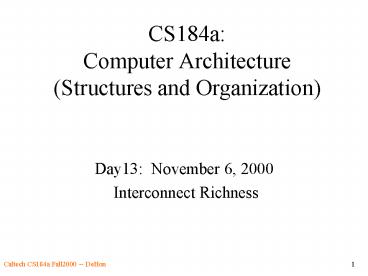CS184a: Computer Architecture (Structures and Organization) - PowerPoint PPT Presentation
Title:
CS184a: Computer Architecture (Structures and Organization)
Description:
Just starting to look at balancing interconnect and logic. Caltech CS184a Fall2000 -- DeHon ... Better results if 'reassociate' rather than keeping original subtrees. ... – PowerPoint PPT presentation
Number of Views:18
Avg rating:3.0/5.0
Title: CS184a: Computer Architecture (Structures and Organization)
1
CS184aComputer Architecture(Structures and
Organization)
- Day13 November 6, 2000
- Interconnect Richness
2
Last Time
- Rents Rule Implication
- Superlinear growth rate of interconnect
- pgt0.5
- gt Area growth O(N2p)
- Just starting to look at balancing interconnect
and logic
3
Today
- How rich should interconnect be
- specifics of understanding interconnect
- methodology for attacking these kinds of
questions
4
Now What?
- There is structure (locality)
- Rent characterizes locality
- How rich should interconnect be?
- Allow full utilization?
- Most area efficient?
- Model requirements and area impact
5
Step 1 Build Architecture Model
- Assume geometric growth
- Pick parameters Build architecture can tune
- F, C
- a, p
6
Tree of Meshes
- Tree
- Restricted internal bandwidth
- Can match to model
7
Parameterize C
8
Parameterize Growth
(2 1) gt a?2
(2 2 2 1) gta2(3/4)
(2 2 1) gt a(22)(1/3) 2(2/3)
9
Step 2 Area Model
- Need to know effect of architecture parameters on
area (costs) - focus on dominant components
- wires
- switches
- logic blocks(?)
10
Area Parameters
- Alogic 40Kl2
- Asw 2.5Kl2
- Wire Pitch 8l
11
Switchbox Population
- Full population is excessive (next lecture)
- Hypothesis linear population adequate
- still to be (dis)proven
12
Cartoon VLSI Area Model
(Example artificially small for clarity)
13
Larger Cartoon
1024 LUT Network
P0.67
LUT Area 3
14
Effects of P (a) on Area
P0.5
P0.67
P0.75
1024 LUT Area Comparison
15
Effects of P on Capacity
16
Step 3 Characterize Application Requirements
- Identify representative applications.
- Today IWLS93 logic benchmarks
- How much structure there?
- How much variation among applications?
17
Application Requirements
Max C7, P0.68 Avg C5, P0.72
18
Benchmark Wide
19
Benchmark Parameters
20
Complication
- Interconnect requirements vary among applications
- Interconnect richness has large effect on area
- What is effect of architecture/application
mismatch? - Interconnect too rich?
- Interconnect too poor?
21
Interconnect Mismatch in Theory
22
Step 4 Assess Resource Impact
- Map designs to parameterized architecture
- Identify architectural resource required
Compare mapping to k-LUTs LUT count vs. k.
23
Mapping to Fixed Wire Schedule
- Easy if need less wires than Net
- If need more wires than net, must depopulate to
meet interconnect limitations.
24
Mapping to Fixed-WS
- Better results if reassociate rather than
keeping original subtrees.
25
Observation
- Dont really want a bisection of LUTs
- subtree filled to capacity by either of
- LUTs
- root bandwidth
- May be profitable to cut at some place other than
midpoint - not require balance condition
- Bisection should account for both LUT and
wiring limitations
26
Challenge
- Not know where to cut design into
- not knowing when wires will limit subtree
capacity
27
Brute Force Solution
- Explore all cuts
- start with all LUTs in group
- consider all balances
- try cut
- recurse
28
Brute Force
- Too expensive
- Exponential work
- viable if solving same subproblems
29
Simplification
- Single linear ordering
- Partitions pick split point on ordering
- Reduce to finding cost of start,end ranges
(subtrees) within linear ordering - Only n2 such subproblems
- Can solve with dynamic programming
30
Dynamic Programming
- Start with base set of size 1
- Compute all splits of size n, from solutions to
all problems of size n-1 or smaller - Done when compute where to split 0,N-1
31
Dynamic Programming
- Just one possible heuristic solution to this
problem - not optimal
- dependent on ordering
- sacrifices ability to reorder on splits to avoid
exponential problem size - Opportunity to find a better solution here...
32
Ordering LUTs
- Another problem
- lay out gates in 1D line
- minimize sum of squared wire length
- tend to cluster connected gates together
- Is solvable mathematically for optimal
- Eigenvector of connectivity matrix
- Use this 1D ordering for our linear ordering
33
Mapping Results
34
Step 5 Apply Area Model
- Assess impact of resource results
35
Resources ? Area Model ? Area
36
Net Area
37
Picking Network Design Point
Dont optimize for 100 compute util. (100
yield) also dont optimize for highest
peak.
38
What about a single design?
39
LUT Utilization predict Area?
Single design
40
Methodology
- Architecture model (parameterized)
- Cost model
- Important task characteristics
- Mapping Algorithm
- Map to determine resources
- Apply cost model
- Digest results
- find optimum (multiple?)
- understand conflicts (avoidable?)
41
Big IdeasMSB Ideas
- Interconnect area dominates logic area
- Interconnect requirements vary
- among designs
- within a single design
- To minimize area
- focus on using dominant resource (interconnect)
- may underuse non-dominant resources (LUTs)
42
Big IdeasMSB Ideas
- Two different resources here
- compute, interconnect
- Balance of resources required varies among
designs (even within designs) - Cannot expect full utilization of every resource
- Most area-efficient designs may waste some
compute resources (cheaper resource)































